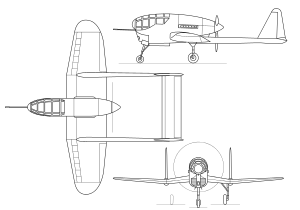De Schelde S.21
| S.21 | |
|---|---|
| Role | Fighter aircraft |
| National origin | Netherlands |
| Manufacturer | NV Koninklijke Maatschappij De Schelde |
| Status | Project abandoned |
| Number built | 1 incomplete prototype |
|
| |
The De Schelde S.21 was a proposed Dutch fighter of the late 1930s and early 1940s. It was a single-seat, single-engined, pusher monoplane. A single prototype was under construction in 1940, but work was abandoned because of the German invasion.
Design and development
The Dutch shipbuilding company NV Koninklijke Maatschappij De Schelde of Vlissingen entered the aviation business in 1935, when it recruited most of the technical staff, including Chief Designer T. E. Slot, of Pander & Son, which had failed in 1934. Early designs built by De Schelde were the De Schelde Scheldemusch, a lightweight single-seater pusher biplane powered by a 40 horsepower (30 kW) Praga B engine, and the Scheldemeeuw, a flying boat version of the Scheldemusch.[1] In 1938, Slot started design work on two more advanced types which also followed Slot's preferred pusher configuration, the De Schelde S.20, a light cabin monoplane, and the S.21, a single-seat fighter, with construction of prototypes for both types beginning in early 1939.[2]
The S.21 was a low-wing cantilever monoplane of all-metal construction. It featured an inverted gull wing, with the aircraft's tail carried on twin booms.[3] The compact fuselage nacelle carried the pilot, engine and the aircraft's armament. The pilot sat in a heavily glazed cockpit in the nose of the nacelle, with the engine, a Daimler-Benz DB 600Ga liquid-cooled inverted V12 engine rated at 1,050 horsepower (780 kW) for takeoff and at 920 horsepower (690 kW) at 4,000 metres (13,000 ft), driving a three-bladed propeller,[lower-alpha 1] was situated immediately behind the pilot. The engine was cooled by a radiator in the nose of the aircraft below the cockpit.[2] A nosewheel undercarriage was fitted.[3]
Armament consisted of a single Madsen 23 mm cannon on a flexible mount in the nose, together with four 7.9 mm FN-Browning machine guns in the side of the nacelle. It was intended that the cannon would be fixed during air-to-air combat, but that for ground strafing operations, the cannon would be released and aimed manually by the pilot, with an automatic stabilising system controlling the aircraft's ailerons and elevators to aid the pilot in keeping control of the aircraft while busy aiming and firing the cannon.<ref name=aifen74 p75">Beeling Air International December 2015, p. 75.</ref>[4]
The prototype S.21 was almost complete when Germany invaded the Netherlands in May 1940, with the De Schelde factory and the prototype S.21 being seized by German troops. Development was abandoned, with the prototype being tested to destruction at Utrecht.<ref name=aifen74 p75"/> Although abandoned, artist impressions of the S.21 were presented in the wartime aviation press as the fictional Focke-Wulf Fw 198.<ref name=aifen74 p75"/>[3]
Specifications (Performance estimated)

Data from Dutch Digression [5]
General characteristics
- Crew: 1
- Length: 7.43 m (24 ft 5 in)
- Wingspan: 9.00 m (29 ft 6 in)
- Height: 2.60 m (8 ft 6 in)
- Empty weight: 1,700 kg (3,748 lb)
- Gross weight: 2,500 kg (5,512 lb)
- Powerplant: 1 × Daimler-Benz DB 600Ga liquid-cooled inverted V12 engine, 780 kW (1,050 hp)
Performance
- Maximum speed: 590 km/h (367 mph; 319 kn) at 4,000 metres (13,000 ft)
- Cruising speed: 520 km/h (323 mph; 281 kn)
- Service ceiling: 10,000 m (32,808 ft)
Armament
- Guns:
1 × 23 mm Madsen cannon
4 × 7.9 mm machine guns
References
- ↑ Beeling Air International December 2015, pp. 73–74.
- ↑ 2.0 2.1 2.2 Beeling Air International December 2015, p. 74.
- ↑ 3.0 3.1 3.2 Green 1961, p. 98.
- ↑ FM30-35: Military intelligence: Identification of German aircraft. United States War Department. 1942. pp. 10–11.
- ↑ Beeling Air International December 2015, pp. 74–75.
- Beeling, M. (February 1974). "Dutch Digression". Air Enthusiast International. Vol.6 (No.2): pp. 69–75.
- Green, William (1961). War Planes of the Second World War: Volume Three Fighters. London: Macdonald.
External links
- S.21 (in Russian)
| ||||||||||||||||||||||